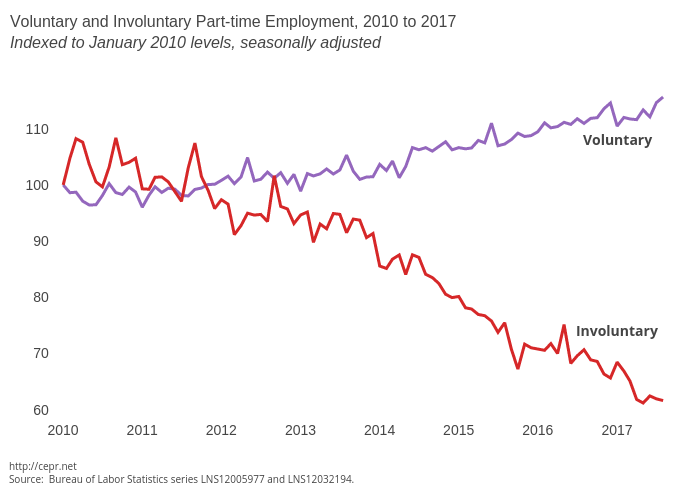September 01, 2017
September 1, 2017 (Jobs Byte)
By Dean Baker
Weakness in wage growth and drop in prime-age EPOPs shows slack in labor market.
The Bureau of Labor Statistics reported that the economy added 156,000 jobs in August, somewhat less than most economists had expected. This figure, combined with downward revisions of 41,000 to the prior two months data, brought the average over the last three months to 185,000. The household survey also showed some evidence of weakness with the unemployment rate edging up to 4.4 percent and the employment-to-population ratio (EPOP) falling back 0.1 percentage point to 60.1 percent.
Perhaps more noteworthy was a drop of 0.3 percentage points in the EPOP of prime-age (ages 25 to 54) workers to 78.4 percent. The EPOP for both prime-age men and women dropped by 0.3 percentage points.
By demographic group, the most notable change was a jump of 0.8 percentage points in the unemployment rate to 7.8 percent for black men, following an increase of 0.7 percentage points in July. While this is troubling, these numbers are erratic. The employment rate for black men is just 0.4 percentage points below its peak for the recovery. The unemployment rate for black women edged down slightly to 6.4 percent, a new low for the recovery.
Other data in the household survey were mostly positive. The number of people involuntarily working part-time fell by 27,000, it is now only slightly larger as a share of the workforce than before the recession. The number of people choosing to work part-time increased by 187,000, reaching a new high. This number has increased by more than 2.6 million since the end of the 2013 when the Affordable Care Act took effect. It indicates that many people are taking advantage of the opportunity to get insurance outside of employment and therefore opting to work part-time.
The percentage of people who are unemployed because they quit their jobs increased to 11.3 percent, but this is still 1.2 percentage points below the peak for the recovery reached last November. One peculiar item in the August report was a big drop in the number of people who are multiple job holders, especially among women. This number, which is not seasonally adjusted, is down 0.4 percentage points from its year-ago level for women and now stands at 4.8 percent of employed women. (It is 4.3 percent for employed men.) This could mean that fewer women feel they need to work more than one job, or it could just be an anomaly that will be reversed in future months.
Wage growth continues to be moderate, with the average hourly wage up 2.5 percent over the last year. The annual rate of increase in the average hourly wage, comparing the last three months with the prior three months, is also 2.5 percent. As a result of the weak growth in the hourly wage and a modest decline in the length of the average workweek, average weekly earnings actually fell slightly in the month.
The job growth in the establishment survey was unusually concentrated in the good producing sector, which accounted for 70,000 new jobs. Manufacturing led the way with a gain of 36,000, of which 13,700 were in autos. Construction added 28,000 jobs, an unusually large gain. Mining added 6,500 jobs as a result of a gain of 6,800 jobs in support activities for mining. Coal mining jobs were unchanged and now stands 2,100 above their year-ago level.
Job growth in health care was just 20,200, down from an average of over 27,000 over the last year. Job growth in restaurants was also weak at 9,200, compared to an average of 23,600 over the last year. Retail added just 800 jobs in August, while the temp sector added 100. (The broader employment services sector added 7,000.) The motion picture industry lost 4,900 jobs pushing employment down by 5.9 percent compared to year-ago levels.
Interestingly, the strong job growth in both construction and manufacturing was associated with a drop in average weekly hours. While the average hourly wage rose modestly in construction, it actually fell in manufacturing and now stands just 1.8 percent above its year-ago level.
On the whole, this is a mixed report. The rate of job growth is respectable but certainly should not raise concerns about being too rapid, especially given continued weakness in wage growth. And the drop in prime-age EPOPs indicates the labor market still has considerable slack.







